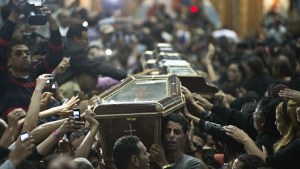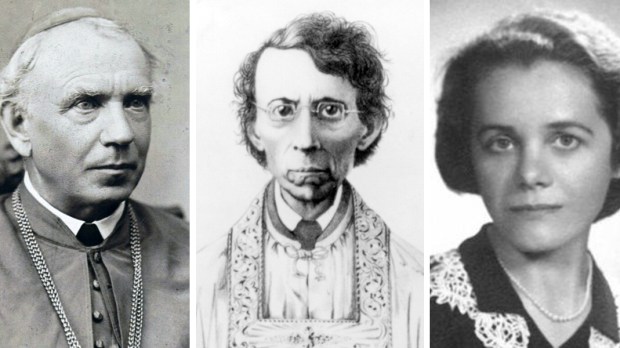After a year of uncertainty, fear, and suffering on a global scale, many of us found ourselves counting down the months to 2021 with some hope that the new calendar year would bring an end to the “unprecedented times” we’ve been suffering through since March. But the end of 2020 didn’t erase the pandemic, restore the global economy, or settle any nation’s political turmoil. Fortunately, we know that saints are forged in times of unrest, perhaps even more readily than in times of stability. As we seek to become saints in a tumultuous world, let’s look to those who’ve gone before, who found holiness even as their worlds seemed to be crumbling around them.
Bl. Jacques Jules Bonnaud (1741-1792) was born in Haiti but sent to France as a child in order to avoid the difficulties his dark skin brought him as a biracial boy in the Americas. In France, he was educated by Jesuits and soon entered the Society of Jesus. When he was still in formation, the Jesuit order was dissolved in France and Bonnaud was forced to find another way to pursue his vocation in a diocesan seminary. Once ordained, Fr. Bonnaud lived according to the Jesuit rule as best he could while serving as a priest in the Archdiocese of Paris; later he became vicar general of Lyon for several years, as the French Revolution rocked the country. He was eventually martyred for refusing to swear allegiance to the state.
Bl. Catherine Jarrige (1754-1836) was a French peasant who tried to subdue her mischievous spirit after becoming a lay Dominican. When the Revolution broke out, though, she discovered that God had made her spirited on purpose. She spent the time of crisis smuggling priests from one place to another, ensuring that no baby went unbaptized and nobody died without the Sacraments. She teased and tricked the revolutionaries, using sarcasm and improvisational acting to save lives. After the Revolution, she went back to a quieter life of begging for the poor, but retained her reputation as the hero of local Catholics.
Ven. Felix Varela y Morales (1788-1853) was a Cuban priest and statesman, a seminary professor whose intellectual contributions to Cuba were so significant that he’s often called, “the one who taught us how to think.” When he was sent as a representative to the Spanish Parliament, Varela took that opportunity to speak out in favor of the abolition of slavery and the freedom of Spanish colonies. He received a death sentence for his trouble, but escaped to New York. There he spent the rest of his life in exile, serving immigrant communities (particularly the Irish) and working to form the Catholic Church in America to lead the way in support of immigrants.
St. Zygmunt Szcesny Felinski (1822-1895) was born to a proudly Polish family at a time when there was no independent Poland. His father died when he was 11; when he was 18, his mother was exiled to Siberia for her pro-Polish sentiment. Zygmunt himself was involved in a failed revolution before becoming a diocesan priest. He was made archbishop of Warsaw while the city was besieged by the Russians, but served in Warsaw for only 16 months before being exiled to Siberia for 20 years. Archbishop Felinski spent the rest of his life in semi-exile in modern Ukraine.
St. Rafael Guízar y Valencia (1878-1938) had no idea the upheaval that awaited him when he was ordained a priest in Mexico at 23. During the Mexican Revolution, he was forced into hiding, living as an undercover priest before fleeing to the United States, Guatemala, and Cuba. After years of exile, he was named bishop of Veracruz and returned to Mexico. Even then, he wasn’t safe, spending half of his 18-year episcopacy in exile or in hiding.
Bl. Natalia Tulasiewicz (1906-1945) was a poet, a violinist, a middle-aged high school teacher with tuberculosis and dreams of a Ph.D. But when the Germans invaded Poland, Natalia became a member of the resistance, secretly teaching Polish culture before sneaking off to a German factory to bring faith and hope to the Polish women forced to work there. The Nazis eventually caught wind of the prayer circles and retreats Natalia was running and sent her to a concentration camp, where she continued to serve as a beacon of hope and an apostle to Ravensbrück until she was killed in a gas chamber.
Ven. Francis Xavier Nguyen Van Thuan (1928-2002) was consecrated archbishop of Saigon at age 47—a week before the fall of Saigon to communist forces. A few months later, he was arrested and placed in a communist internment camp for 13 years, nine of which he spent in solitary confinement. During that time, Archbishop Van Thuan evangelized his guards, celebrated Mass with his hand as a chalice, and smuggled messages of hope to his people. He was finally freed but sent into exile for his last 11 years.
Servant of God Ragheed Aziz Ganni (1972-2007) was a popular young priest who played soccer and gave talks at youth rallies. He spent his priesthood rallying his people in the face of incessant terrorist attacks on Christians in his hometown of Mosul. Fr. Ganni’s parish was attacked at least 10 times, but he refused to live in fear, saying, “Without the Sunday Eucharist we cannot live.” He was killed by terrorists for refusing to keep his church closed after they threatened him.

Read more:
Pope Francis to Coptic Patriarch: “We are united in the blood of our martyrs”

